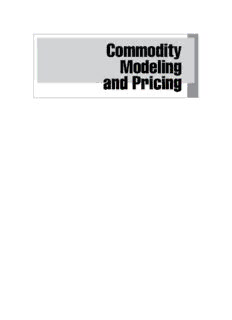
Commodity Modeling and Pricing: Methods for Analyzing Resource Market Behavior PDF
Preview Commodity Modeling and Pricing: Methods for Analyzing Resource Market Behavior
Commodity Modeling and Pricing Founded in 1807, John Wiley & Sons is the oldest independent publishing com- pany in the United States. With offices in North America, Europe, Australia and Asia,Wileyisgloballycommittedtodevelopingandmarketingprintandelectronic products and services for our customers’ professional and personal knowledge and understanding. The Wiley Finance series contains books written specifically for finance and investment professionals as well as sophisticated individual investors and their fi- nancialadvisors.Booktopicsrangefromportfoliomanagementtoe-commerce,risk management, financial engineering, valuation and financial instrument analysis, as wellasmuchmore. Foralistofavailabletitles,pleasevisitourWebsiteatwww.WileyFinance.com. Commodity Modeling and Pricing Methods for Analyzing Resource Market Behavior PETER V. SCHAEFFER John Wiley & Sons, Inc. Copyright(cid:2)C 2008byPeterV.Schaeffer.Allrightsreserved. PublishedbyJohnWiley&Sons,Inc.,Hoboken,NewJersey. PublishedsimultaneouslyinCanada. Nopartofthispublicationmaybereproduced,storedinaretrievalsystem,ortransmittedin anyformorbyanymeans,electronic,mechanical,photocopying,recording,scanning,or otherwise,exceptaspermittedunderSection107or108ofthe1976UnitedStatesCopyright Act,withouteitherthepriorwrittenpermissionofthePublisher,orauthorizationthrough paymentoftheappropriateper-copyfeetotheCopyrightClearanceCenter,Inc.,222 RosewoodDrive,Danvers,MA01923,(978)750-8400,fax(978)750-4470,orontheweb atwww.copyright.com.RequeststothePublisherforpermissionshouldbeaddressedtothe PermissionsDepartment,JohnWiley&Sons,Inc.,111RiverStreet,Hoboken,NJ07030, (201)748-6011,fax(201)748-6008,oronlineathttp://www.wiley.com/go/permissions. LimitofLiability/DisclaimerofWarranty:Whilethepublisherandauthorhaveusedtheir besteffortsinpreparingthisbook,theymakenorepresentationsorwarrantieswithrespect totheaccuracyorcompletenessofthecontentsofthisbookandspecificallydisclaimany impliedwarrantiesofmerchantabilityorfitnessforaparticularpurpose.Nowarrantymay becreatedorextendedbysalesrepresentativesorwrittensalesmaterials.Theadviceand strategiescontainedhereinmaynotbesuitableforyoursituation.Youshouldconsultwitha professionalwhereappropriate.Neitherthepublishernorauthorshallbeliableforanyloss ofprofitoranyothercommercialdamages,includingbutnotlimitedtospecial,incidental, consequential,orotherdamages. Forgeneralinformationonourotherproductsandservicesorfortechnicalsupport,please contactourCustomerCareDepartmentwithintheUnitedStatesat(800)762-2974,outside theUnitedStatesat(317)572-3993orfax(317)572-4002. Wileyalsopublishesitsbooksinavarietyofelectronicformats.Somecontentthatappears inprintmaynotbeavailableinelectronicbooks.FormoreinformationaboutWiley products,visitourwebsiteatwww.wiley.com. LibraryofCongressCataloging-in-PublicationData: Schaeffer,PeterV. Commoditymodelingandpricing:methodsforanalyzingresourcemarketbehavior/ PeterV.Schaeffer. p.cm.–(Wileyfinanceseries) Includesindex. ISBN978-0-470-31723-5(cloth) 1.Commodityexchanges–Mathematicalmodels. 2.Primarycommodities–Prices. 3.Prices–Mathematicalmodels. I.Title. HG6046.S3532008 332.64(cid:3)4–dc22 2008022839 PrintedintheUnitedStatesofAmerica 10 9 8 7 6 5 4 3 2 1 In Memoriam Daniel J. Gijsbers and Thomas F. Torries Contents Preface ix Acknowledgments xi PARTONE DynamicsofCommodityPriceBehavior 1 CHAPTER1 IndirectInferenceandLongMemory:ANewTruncated-Series EstimationMethod—ArmandSadler,Jean-BaptisteLesourd,and VeˆlayoudomMarimoutou 3 CHAPTER2 ProcyclicalityofPrimaryCommodityPrices:AStylizedFact?— A.BehroozAfrasiabi 30 CHAPTER3 NonlinearFeaturesofComovementsbetweenCommodityPrices andInflation—CatherineKyrtsou 52 CHAPTER4 TheOilPriceandtheDollarReconsidered—SadekMelhemand MichelTerraza 65 PARTTWO InventoryDynamicsandPriceBehavior 77 CHAPTER5 Time-VaryingRatiosofPrimaryandScrapMetalPrices:Importance ofInventories—IreneM.Xiarchos 79 CHAPTER6 MetalPricesandtheSupplyofStorage—PaulCromptonand IreneM.Xiarchos 103 vii viii CONTENTS CHAPTER7 TestingforTemporalAsymmetryintheMetalPrice-Stock Relationship—EugeneKouassi 118 CHAPTER8 DoFluctuationsinWineStocksAffectWinePrices?—JamesO.Bukenya 136 PARTTHREE DynamicsofResourceMarkets 167 CHAPTER9 DynamicQuadraticProgramminginProcessControl—BruceA.Bancroft 169 CHAPTER10 PollutionTaxesandPriceControlintheUSCoalMarket:ARent MinimizationModel—ChinW.YangandMing-JengHwang 176 CHAPTER11 AForecastingSimulationofCoalinIndonesia’sEnergyFuture— UkarW.Soelistijo 185 CHAPTER12 StructuralDecompositionAnalysisofChangesinMaterialDemandin theU.S.Economy—AdamRoseandChia-YonChen 195 PARTFOUR EnvironmentalResourceDynamics 209 CHAPTER13 LinkingTradeandtheEnvironmentinChina—HaixiaoHuang 211 CHAPTER14 CriticalNeedsinChina’sWaterResources—AndresLiebenthal 229 CHAPTER15 PublicInputinRuralLandPreservation:ModelingPreference AsymmetriesinStatedPreferenceData—RobertJ.Johnstonand KellyGiraudCullen 247 CHAPTER16 AfricanWomeninMiningPartnerships—BrigitteBocoum 267 EPILOGUE ConclusionsandPerspective—WalterC.Labys 279 ListofContributors 289 Index 295 Preface R esource commodity markets are extremely important to agricultural producers, processors, consumers, foresters, and the wood processing industry and in the mineral and energy industries. They play a central role in economic development, internationaltrade,andglobaleconomicandpoliticalstability.Globalizationandthe spectaculargrowthandindustrialdevelopmentofChina,India,andotherSoutheast Asiancountries have significantlyadded tototalresourcecommodity demands and causedpriceincreases.Additionalpressuresonpriceshavecomefromanincreased useofagriculturalcommodities,particularlycornandsugar,forethanolproduction, arecentdevelopmentthathashadsignificantimpactsonfoodprices.Ingeneral,the closer integrationofresource marketshas been accompanied bygrowingeconomic andfinancialinstability. Resource-producing countries need export revenues: Brazil, from Amazon tim- ber; Chile, from copper; Iraq, from crude oil; South Africa, from diamonds; and Argentina and the United States, from wheat. Resource-consuming countries need imports for industry: China, India, and Japan for raw materials and energy, the UnitedStatesforcrudeoil.Becauseofcyclesinconsumptionandproduction,these markets face high price instability. More than 60 commodity futures markets exist toamelioratethisproblem.Worldcommoditymarketsareagainunderscrutiny,and theeconomicanalysisandmodelingofthesemarketsisasimportantaseverbefore. This collection of chapters reflects the influence of Professor Walter C. Labys onthedevelopmentofeconometricmethodsforforecastingcommodityprices.The contributors are former students and collaborators, ranging from practitioners in private industry, public sector and nongovernmental organizations, to scholars in highereducation.TheyarefromAustralia,China,France,Indonesia,theIvoryCoast, Luxembourg, Tunisia, and the United States. Some of them came together in Mor- gantown,WestVirginia,ontheoccasionofProfessorLabys’sretirementfromWest VirginiaUniversityforasymposiumshowcasingthecurrentstateoftheartincom- moditypricemodelingandforecasting,whiletheothersjoinedthemlatertoproduce thisvolume. During his career, which spanned over 40 years, Professor Labys published 15 books, 150 research articles, and gave 130 invited lectures. His many honors and recognitionsincludebeingappointedthefirstGunnarMyrdalScholarbytheUnited NationsinGeneva,receivingaMasterKnighthoodintheBrotherhoodoftheVinein California,beingnamedaBenedumDistinguishedScholaratWestVirginiaUniver- sity,andgarneringtheWilliamH.MiernykAwardforCareerScholarlyAchievement bytheRegionalResearchInstituteatWestVirginiaUniversity. Professor Labys grew up in southwest Pennsylvania. He received his under- graduate education at Carnegie Tech, now Carnegie Mellon University, where he studiedengineeringandalsotookcoursesinpaintingandsculpture.Hethenearned ix x PREFACE a master’s degree in Economics at Harvard University. While attending a seminar presentationthere,hemetProfessorCliveW.J.Granger,whowouldlaterbecomethe 2003 Nobel laureate in economics. When Professor Granger moved to the Univer- sityofNottingham,ProfessorLabysfollowedhimtocompleteaPh.D.inEconomics underhisdirection. Shortly after receiving his Ph.D., he started work as a consultant for the Com- moditiesDivisionattheWorldBank,whereachanceencounterwithAlfredMaizels led to an invitation to join the United Nations Conference on Trade and Devel- opment in Geneva as a commodities specialist. At the time, the United Nations in Geneva was a virtual whirlwind of economic activity and research, and Professor Labys encountered many eventual Nobel laureates in Economics. He was coached through his first commodity model by Lawrence Klein, and made the acquaintance ofHarryJohnston,RobertMundell,JamesMeade,andRichardStone. Eventually Professor Labys moved back to the United States, opting for West Virginia University in Morgantown to be near his parents, rather than joining his doctoral advisor, Professor Granger, at the University of California in San Diego. His work continued to take him back to Europe, where he consulted with the United Nations in Geneva, the Food and Agriculture Organization in Rome, and theInternationalInstituteforAppliedSystemsAnalysisinViennawhilemaintaining academicaffiliationswithseveralFrenchuniversities. Duringhislongcareer,ProfessorLabysservedasadvisortomanystudentsboth in the United States and abroad. His relationship with his doctoral students was characterized by strong support, with a willingness to help at any time and in any waypossible.Thiscollectionofchaptersisinparttheresultofsuchrelationships. W.PAULLABYS CRAInternational,SaltLakeCity,Utah PETERV.SCHAEFFER WestVirginiaUniversity,Morgantown,WestVirginia Acknowledgments T heDivisionofResourceManagementandtheRegionalResearchInstitutefinan- ciallysupportedthesymposiumthatbroughttogethertheinitialcoreofspeakers andpapersthatledtotheideaforthisbook.MyWestVirginiaUniversitycolleagues JeraldJ.FletcherandTimT.Phippsprovidedorganizationalsupportforthesympo- sium,asdidoursecretary,LisaLewis.RandallW.Jackson,directoroftheRegional ResearchInstitute,providedadditionalfundingfortechnicalsupportduringthepro- ductionofthemanuscript.WalterLabystookpleasureandprideinthisprojectand provided feedback and editorial advice on many issues and chapters. I benefited greatly from the advice and guidance of John Wiley & Sons’ Debra W. Englander, Executive Editor, Stacey Small, Editorial Assistant, Kelly O’Connor, Development Editor, and Michael Lisk, Senior Production Editor. Jacquelyn Strager created the base map of Indonesia that served as the basis for Figure 11.1 and Gloria Nestor assistedwithFigure14.1.IkaRahmawatihelpedwithtranslatingstatisticalinforma- tionfromIndonesianintoEnglish.WeslieBoyd’sexpertassistancewasinvaluablein gettingthemanuscriptreadytomeetthepublisher’sguidelines. Editing this book was interesting and rewarding, but also time consuming and at times, it interfered with family life. I therefore very gratefully acknowledge my wife’slove,support,andpatience. PETERV.SCHAEFFER xi
Description: